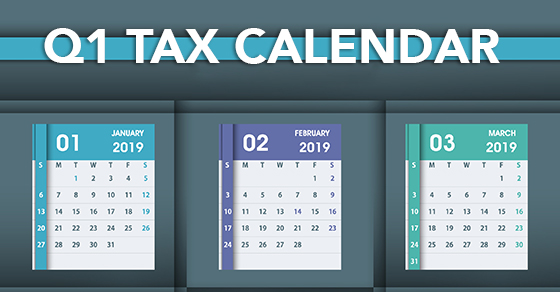Here are some of the key tax-related deadlines affecting businesses and other employers during the first quarter of 2019. Keep in mind that this list isn’t all-inclusive, so there may be additional deadlines that apply to you. Contact us to ensure you’re meeting all applicable deadlines and to learn more about the filing requirements.
January 31
- File 2018 Forms W-2, “Wage and Tax Statement,” with the Social Security Administration and provide copies to your employees.
- Provide copies of 2018 Forms 1099-MISC, “Miscellaneous Income,” to recipients of income from your business where required.
- File 2018 Forms 1099-MISC reporting nonemployee compensation payments in Box 7 with the IRS.
- File Form 940, “Employer’s Annual Federal Unemployment (FUTA) Tax Return,” for 2018. If your undeposited tax is $500 or less, you can either pay it with your return or deposit it. If it’s more than $500, you must deposit it. However, if you deposited the tax for the year in full and on time, you have until February 11 to file the return.
- File Form 941, “Employer’s Quarterly Federal Tax Return,” to report Medicare, Social Security and income taxes withheld in the fourth quarter of 2018. If your tax liability is less than $2,500, you can pay it in full with a timely filed return. If you deposited the tax for the quarter in full and on time, you have until February 11 to file the return. (Employers that have an estimated annual employment tax liability of $1,000 or less may be eligible to file Form 944,“Employer’s Annual Federal Tax Return.”)
- File Form 945, “Annual Return of Withheld Federal Income Tax,” for 2018 to report income tax withheld on all nonpayroll items, including backup withholding and withholding on accounts such as pensions, annuities and IRAs. If your tax liability is less than $2,500, you can pay it in full with a timely filed return. If you deposited the tax for the year in full and on time, you have until February 11 to file the return.
February 28
- File 2018 Forms 1099-MISC with the IRS if 1) they’re not required to be filed earlier and 2) you’re filing paper copies. (Otherwise, the filing deadline is April 1.)
March 15
- If a calendar-year partnership or S corporation, file or extend your 2018 tax return and pay any tax due. If the return isn’t extended, this is also the last day to make 2018 contributions to pension and profit-sharing plans.







